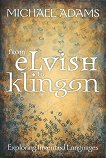With this new guide, compiled by Michael Adams, author of the bestselling Slayer Slang: A Buffy the Vampire Stayer Lexicon, you can take a tour of a brave new world of invented languages, and explore their fascinating landscapes with some of the leading linguists and creators of new languages (or conlangs), including Marc Okrand, the inventor of Klingon.
Spanning a wide range of constructed languages, from Esperanto to Orwell’s Newspeak, and from Tolkien’s Elvish dialects to gaming languages like Gargish and Simlish, this volume is a must-have for language lovers and linguists keen to learn more about invented languages.
Arika Okrent wrote the excellent and very readable In the Land of Invented Languages, referenced many times here. This book covers some of the same languages, but branches out into a more diverse range that could potentially be considered to be “invented”, with a much wider scope than implied by the examples chosen for the title. The various chapters (discussed below) are contributed by individual experts in the specific areas, and, as with most collections, this results in a somewhat choppy, uneven style, but it does mean that is can be read piecemeal, chapter by chapter. Adams provides his own short appendix (unfortunately printed in a microscopic font size) to accompany each chapter, expanding on some of the issues raised.
An interesting addition to the invented language literature.
Contents
- • The spectrum of invention. 2011
- This chapter provides an introduction to and scoping of the overall book,
discussing how and why languages are invented, and what might be included as an invented language.
The appendix “Owning language” discusses how different language inventors attempt to control their languages, with greater or lesser success. - • Arden R. Smith. Confounding Babel: international auxiliary languages. 2011
- Smith provides a fascinating historical and biographical overview of
the more obvious candidates for invented languages,
including Volapük and Esperanto, and of simplified natural languages,
including regularised Latin, Basic English, Weltdeutsch, and Saxon English
(shades of Poul Anderson’s “Uncleftish Beholding” here).
Adams’ appendix “Esperanto’s zentih” provides some contemporary historical insight into Esperanto, with many acerbic news clippings. - • Howard Jackson. Invented vocabularies: the cases of Newspeak and Nadsat. 2011
- Newspeak (from Orwell’s 1984)
and the Russian-derived Nadsat (from Burgess’ A Clockwork Orange)
are not entire languages,
but this chapter unpicks their underlying logic to show that
they are more than just a few random invented words.
Adams’ appendix “Nadsat and the critics” quotes some contemporary reviews. - • Edmund S. C. Weiner, Jeremy Marshall. Tolkien's invented languages. 2011
- A look at the development of Sindarin, Quenya, and Orkish, both at how they developed over real
time as Tolkien adjusted his mythology, and at their derivation from a common fictional root.
Adams’ appendix “Tolkien’s languages: a brief anthology of commentary” references some contemporary critiques. - • Mark Okrand, Michael Adams, Judith Hendriks-Hermans, Sjaak Kroon. 'Wild and whirling words': the invention and use of Klingon. 2011
- The inventor of Klingon provides an account of its genesis, structure, rationale, and subsequent uses.
Adams’ appendix “Advanced Klingon” gives examples of classics translated into Klingon, particularly Hamlet. - • James Portnow. Gaming languages and language games. 2011
- Not all imagined worlds are in books: some are in sophisticated computer games,
and this chapter discusses a few languages that have been invented for interactive games,
and the extra constraints there are on such languages, in particular,
that it be rewarding (games should be fun),
easy to learn (the aim is to play the game, not learn a new language),
and inessential for playing the game (to cater for those players who are not linguistic enthusiasts).
The chapter covers Gargish,
D'ni,
Simlish,
Al-Bhed,
Logos, and
l337 (leet).
In some the languages very few actual example phrases are given, which makes it
a little hard at times to understand the points being made.
Adams’ appendix “L4ngu4ge g4m35 in g4ming l4ngu4g35” gives a leet lexicon. - • Stephen Watt. 'Oirish' inventions: James Joyce, Samuel Beckett, Paul Muldoon. 2011
- This chapter is a discussion of the inventive language games played by certain Irish writers who found
English (or any other existing language) to be less than sufficient for their needs.
I found this the least helpful chapter, as it assumes significant familiarity with the material
in question, unlike the other chapters.
Adams’ appendix “The case for synthetic Scots” is an interesting account of Lallans. - • Suzanne Romaine. Revitalized languages as invented languages. 2011
- Some languages have dies out, either completely or nearly,
then been revitalised, usually for nationalistic reasons.
This chapter covers Modern Hebrew, Māori, Hawai‘ian, Cornish,
and Breton, among others, as examples of revitalised languages.
There are several issues.
There are difficulties in bringing the languages up-to-date with modern vocabulary
that is somehow faithful to the original language,
and even more difficulties on agreeing how to spell both the new and the original the words,
particularly when the original language had several dialects.
And there are tensions between the few remaining native speakers (often poor)
and the school-taught middle-class who speak a reconstructed variant language
for political reasons as a second language:
each find the other inauthentic.
Adams’ appendix “A reconstructed universal language” closes the circle, and discusses neo-Latin.
